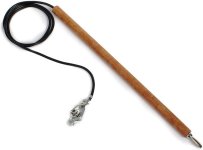The time to wait for a self discharge is a very good question.
And, it should be distinguished from the notion of shorting a capacitor out, to achieve the same effect (not a good idea).
Shorting capacitors directly into a low Ohmic pathway, I regard as stupidity and potentially destructive.
It is seldom required, if patience prevails.
If not, it should be done with a resistor to limit the current. Otherwise you will blow fragments off terminals with high initial peak currents.
The initial current, before the exponential decay of course, is the voltage divided by the ( resistance of the short + the capacitor's ESR).
I never directly short out any capacitor, including a charged CRT. Consider the initial peak current of a capacitor charged to 10kV and shorted into a low Ohmic pathway of less than 10 Ohms.
Generally the charge storage in electrolytic capacitors, which, for the most part, are the only ones that have the ability to store enough energy to give you a reasonable shock, have a relatively high self discharge rate, even when the designer has not even bothered to apply bleeder resistors to discharge them in a brief manner, meaning some minutes. Most electrolytics, have self discharged over a few hours, so you can bet if you leave them for 24Hrs, that task is self done.
The same applies to most CRT's.
Just to cite an example, a typical CRT, such as the one used in the PET computer I am currently working on, runs at a final anode voltage of 10kV. The capacitance between the internal an external Aquadag is close to 500pF. So the energy stored in the capacitance, at the moment the VDU is switched off is (CV^2/2), it is only a measly 25mJ which doesn't have a hope in Hell of harming a Human Being as a single discharge (farmer's electric fences; many put out a few joules of energy), yet you will see all sorts of ridiculous advice on the internet about discharging a CRT before it is safe to work on the VDU. To be exposed to this charge in the first instance, you have to go under the Anode cap, which is seldom required for most VDU servicing anyway.
And the worst of it is, if you short that charged 500pF capacitance to some earth point with a wire (as the Youtube videos from the supposed experts suggest) , the transient initial peak currents can be enormous and damage semiconductors in the unit.
In reality, because the semiconductor EHT rectifiers in the VDU's EHT circuit, have non-zero leakage, if you don't want that small harmless zap when you remove the anode cap from the CRT, just leave the VDU switched off overnight , the charge will dissipate. When you take off the Anode cap the next day, you won't feel a thing. But even if you took off the Anode cap 3 seconds after you turned off the VDU, it won't harm you, unless say you withdraw your hand quickly and cut it on a sharp object. Manufacturers suggested discharging the CRT's for another reason. If you are carrying one, and got a zap from the charge on the anode terminal, you might drop it on the floor.
On the other hand, if you had some high uF value high voltage caps that were not electrolytics, with a very low discharge rate, and charged up, especially if they are holding a few Joules of energy or more, it is sensible to discharge them with a resistor.
If one was very impatient, and had a large CRT with a higher anode voltage and a higher bulb capacitance, say a large CRT with 2000pF capacitance and charged to 25kV and charged to just over half a Joule, and you felt compelled to discharge it, if you didn't want to wait 24hrs for it to self discharge via the EHT rectifier leakage, and you had to go under the anode cap ASAP, the discharge is best done via a very high Ohmic value resistor, in the range of 100M Ohm to 1 G Ohm, as found in a typical CRT EHT probe.
There is another odd scenario, where you discharge a capacitor, and it self charges up again (a type of dielectric absorption), after you release the discharge resistor. This sort of thing tended to happen with gigantic uF value capacitors, such as 50,000uF types used in early computer power supplies. The manufacturers would supply these caps with a resistor connected across their terminals to prevent the capacitor from impersonating a battery.

